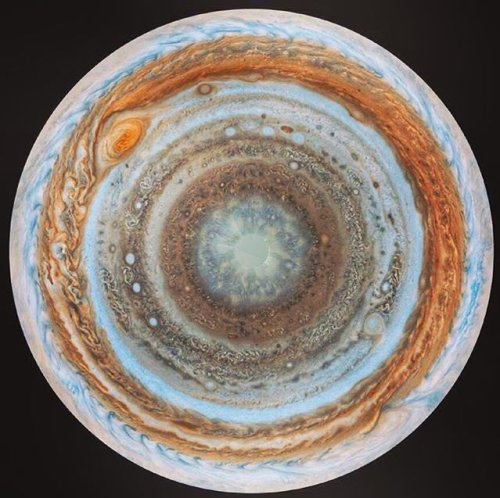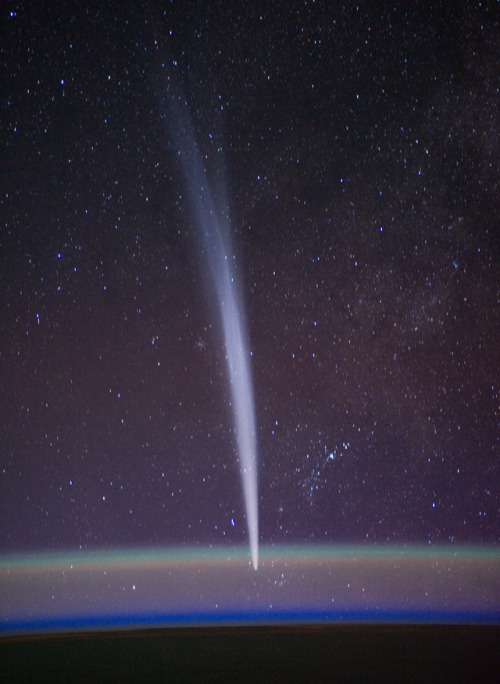Awesome Long-exposure Shot Of A Rocket Launch

Awesome long-exposure shot of a Rocket Launch
via reddit
More Posts from Xnzda and Others

Beware of the Big, Bad Wolf
Visible within the center of the Crescent nebula is what’s classified as a Wolf-Rayet star. This star is a staggering 250,000 times brighter than the Sun, 15 times more massive, and 3.3 times larger. Its surface temperature is nearly 70,000° C/ 125,000° F. At just 4.7 million years old, it is already toward the end of it’s life and is shedding its outer envelope, ejecting the equivalent of the Sun’s mass every 10,000 years. Within a few hundred thousand years, it is expected to explode as a supernova. (Image Credit: Michael Miller, Jimmy Walker)

M94: Bursting With Stars
Located about 16 million light-years away, this new Hubble image shows the sparkling galaxy Messier 94. You’ll notice the bright ring (or starburst ring) around Messier 94 where new stars are forming at a high rate. The cause of this star-forming region is thought to be a pressure wave going outwards from the galactic center, compressing the gas and dust in the outer region. The compression of material means the gas starts to collapse into denser clouds. Inside these dense clouds, gravity pulls the gas and dust together until temperature and pressure are high enough for stars to be born. (Image credit: NASA / ESA / Hubble)
What is it Like to Visit Jupiter?
Jupiter is the largest planet in our solar system. For some perspective, if it were hollow, more than 1,300 Earths could fit inside of it! The giant planet contains two-thirds of all the planetary mass in the solar system and holds more than dozens of moons in its gravitational grip. But what about a visit to this giant planet?

Let’s be honest…Jupiter is not a nice place to visit. It’s a giant ball of gas and there’s nowhere to land. Any spacecraft – or person – passing through the colorful clouds gets crushed and melted. On Jupiter, the pressure is so strong it squishes gas into liquid. Its atmosphere can crush a metal spaceship like a paper cup.

Jupiter’s stripes and swirls are cold, windy clouds of ammonia and water. Jupiter’s Great Red Spot is a giant storm BIGGER THAN EARTH! This storm has lasted hundreds of years.

Since Jupiter’s atmosphere is made up of mostly hydrogen and helium, it’s poisonous. There’s also dangerous radiation, more than 1,000 times the lethal level for a human.
Scientists think that Jupiter’s core may be a thick, super hot soup…up to 50,000 degrees! Woah!
The Moons

Did you know that Jupiter has its own “mini solar system” of 50 moons? Scientists are most interested in the Galilean satellites – which are the four largest moons discovered by Galileo Galilei in 1610.
Today, Galileo would be astounded to know some of the facts about these moons. The moon Io has active volcanos. Ganymede has its own magnetic field while Europa has a frozen crust with liquid-water underneath making it a tempting place to explore for future missions.

When Juno arrives to Jupiter on July 4, it will bring with it a slew of instruments such as infrared imager/spectrometer and vector magnetometer among the half a dozen other scientific tools in its payload.
Juno will avoid Jupiter’s highest radiation regions by approaching over the north, dropping to an altitude below the planet’s radiation belts – which are analogous to Earth’s Van Allen belts, but far more deadly – and then exiting over the south. To protect sensitive spacecraft electronics, Juno will carry the first radiation shielded electronics vault, a critical feature for enabling sustained exploration in such a heavy radiation environment.
Follow our Juno mission on the web, Facebook, Twitter, YouTube and Tumblr.
Make sure to follow us on Tumblr for your regular dose of space: http://nasa.tumblr.com

The Egg Nebula
The Egg Nebula is approximately 3,000 Light years away from Earth.Resembling a rippling pool illuminated by underwater lights, the Egg Nebula offers astronomers a special look at the normally invisible dust shells swaddling an aging star. These dust layers, extending over one-tenth of a light-year from the star, have an onionskin structure that forms concentric rings around the star.
Image credit: NASA
-
 escuelz reblogged this · 8 months ago
escuelz reblogged this · 8 months ago -
 realbey liked this · 1 year ago
realbey liked this · 1 year ago -
 tewz liked this · 1 year ago
tewz liked this · 1 year ago -
 canogamzeli reblogged this · 1 year ago
canogamzeli reblogged this · 1 year ago -
 canogamzeli liked this · 1 year ago
canogamzeli liked this · 1 year ago -
 onlylovee liked this · 1 year ago
onlylovee liked this · 1 year ago -
 benianlasan liked this · 1 year ago
benianlasan liked this · 1 year ago -
 efendibey liked this · 1 year ago
efendibey liked this · 1 year ago -
 in-the-dark24 liked this · 1 year ago
in-the-dark24 liked this · 1 year ago -
 xghost-of-reblogsx liked this · 1 year ago
xghost-of-reblogsx liked this · 1 year ago -
 mars00 liked this · 1 year ago
mars00 liked this · 1 year ago -
 appreciatethejourney liked this · 1 year ago
appreciatethejourney liked this · 1 year ago -
 tropicanapuppy reblogged this · 1 year ago
tropicanapuppy reblogged this · 1 year ago -
 tropicanapuppy liked this · 1 year ago
tropicanapuppy liked this · 1 year ago -
 angelayasmim liked this · 1 year ago
angelayasmim liked this · 1 year ago -
 nholedsidevi liked this · 1 year ago
nholedsidevi liked this · 1 year ago -
 hey-slow-down-grab-the-rauhl liked this · 1 year ago
hey-slow-down-grab-the-rauhl liked this · 1 year ago -
 jerznegrogato reblogged this · 2 years ago
jerznegrogato reblogged this · 2 years ago -
 toeg liked this · 2 years ago
toeg liked this · 2 years ago -
 harrystylesgotmefuckedup liked this · 2 years ago
harrystylesgotmefuckedup liked this · 2 years ago -
 thefuckupdotcom reblogged this · 2 years ago
thefuckupdotcom reblogged this · 2 years ago -
 jiggyflvcko reblogged this · 2 years ago
jiggyflvcko reblogged this · 2 years ago -
 fad1d reblogged this · 2 years ago
fad1d reblogged this · 2 years ago -
 earth2ersule reblogged this · 2 years ago
earth2ersule reblogged this · 2 years ago -
 blvkboyfly reblogged this · 2 years ago
blvkboyfly reblogged this · 2 years ago -
 blvkboyfly liked this · 2 years ago
blvkboyfly liked this · 2 years ago -
 8vni liked this · 2 years ago
8vni liked this · 2 years ago -
 illmaticlady liked this · 2 years ago
illmaticlady liked this · 2 years ago -
 btwnrealmz reblogged this · 2 years ago
btwnrealmz reblogged this · 2 years ago -
 blessedanddedicated reblogged this · 2 years ago
blessedanddedicated reblogged this · 2 years ago -
 ggmnysnpr reblogged this · 2 years ago
ggmnysnpr reblogged this · 2 years ago -
 notoriousnorm4n reblogged this · 2 years ago
notoriousnorm4n reblogged this · 2 years ago -
 blckdina reblogged this · 2 years ago
blckdina reblogged this · 2 years ago -
 dopesoundz21 reblogged this · 2 years ago
dopesoundz21 reblogged this · 2 years ago












